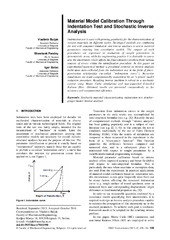Приказ основних података о документу
Kalibrisanje konstitutivnih modela korišćenjem instrumentalnog utiskivanja i stohastičke inverzne analize
Material model calibration through indentation test and stochastic inverse analysis
| dc.creator | Buljak, Vladimir | |
| dc.creator | Pandey, Shwetank | |
| dc.creator | Balać, Igor | |
| dc.date.accessioned | 2022-09-19T18:07:46Z | |
| dc.date.available | 2022-09-19T18:07:46Z | |
| dc.date.issued | 2017 | |
| dc.identifier.issn | 1451-2092 | |
| dc.identifier.uri | https://machinery.mas.bg.ac.rs/handle/123456789/2531 | |
| dc.description.abstract | Eksperiment instrumentalnog utiskivanja se sve više koristi za karakterizaciju materijala različitog tipa. Razvijene metode kombinuju ovaj test sa kompjuterskom simulacijom u okviru inverznih analiza sa ciljem dobijanja parametara koji ulaze u jednačine različitih konstitutivnih modela. Izlaz iz ovakvih procedura predstavljaju vrednosti traženih parametara u determinističkom smislu, dok je za praktičnu inženjersku upotrebu poželjno raspolagati i sa procenom tačnosti dobijenih vrednosti. U ovom radu prikazana je numeričko-eksperimentalna metoda zasnovana na inverznoj analizi koja kao ulazni podatak koristi eksperimentalno izmerenu krivu utiskivanja (kriva koja daje zavisnost primenjene sila u funkciji ostvarene dubine utiskivanja). Numeričke simulacije testa utiskivanja su značajno ubrzame primenom redukovanog modela zasnovanog na pravilnoj ortogonalnoj dekompoziciji a posebno razvijenom za ovu svrhu. Rezultijući inverzni problem je rešen u stohastičkom kontekstu korišćenjem Monte Karlo simulacija kao i Kalmanovih filtera. Dobijeni rezultati su komparativno prezentovani u cilju poređenja dobijene tačnosti i računarske efikasnosti. | sr |
| dc.description.abstract | Indentation test is used with growing popularity for the characterization of various materials on different scales. Developed methods are combining the test with computer simulation and inverse analyses to assess material parameters entering into constitutive models. The outputs of such procedures are expressed as evaluation of sought parameters in deterministic sense, while for engineering practice it is desirable to assess also the uncertainty which affects the final estimates resulting from various sources of errors within the identification procedure. In this paper an experimental-numerical method is presented centered on inverse analysis build upon data collected from the indentation test in the form of force-penetration relationship (so-called 'indentation curve'). Recursive simulations are made computationally economical by an 'a priori' model reduction procedure. Resulting inverse problem is solved in a stochastic context using Monte Carlo simulations and non-sequential Extended Kalman filter. Obtained results are presented comparatively as for accuracy and computational efficiency. | en |
| dc.publisher | Univerzitet u Beogradu - Mašinski fakultet, Beograd | |
| dc.relation | info:eu-repo/grantAgreement/EC/FP7/606878/EU// | |
| dc.rights | openAccess | |
| dc.rights.uri | https://creativecommons.org/licenses/by/4.0/ | |
| dc.source | FME Transactions | |
| dc.subject | Stochastic material characterization | en |
| dc.subject | inverse analyses | en |
| dc.subject | indentation test | en |
| dc.subject | drucker-prager model | en |
| dc.title | Kalibrisanje konstitutivnih modela korišćenjem instrumentalnog utiskivanja i stohastičke inverzne analize | sr |
| dc.title | Material model calibration through indentation test and stochastic inverse analysis | en |
| dc.type | article | |
| dc.rights.license | BY | |
| dc.citation.epage | 116 | |
| dc.citation.issue | 1 | |
| dc.citation.other | 45(1): 109-116 | |
| dc.citation.rank | M24 | |
| dc.citation.spage | 109 | |
| dc.citation.volume | 45 | |
| dc.identifier.doi | 10.5937/fmet1701109B | |
| dc.identifier.fulltext | http://machinery.mas.bg.ac.rs/bitstream/id/1268/2528.pdf | |
| dc.identifier.scopus | 2-s2.0-85011356908 | |
| dc.identifier.wos | 000408082100018 | |
| dc.type.version | publishedVersion |


